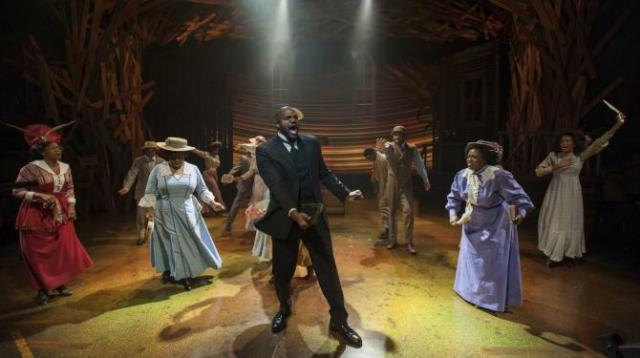

Hope, faith, redemption and courage, set in rural Georgia in 1911, are themes at the heart of The Color Purple.A Milwaukee Repertory Theater production of this 2005 musical, based on the 1982 novel by Alice Walker and the movie that followed it, marks the unofficial opening of the city’s theater season.
This reviewer must admit a certain bias regarding the musical Color Purple, thinking of it as a distant third contender to Alice Walker’s spectacular novel and the film, which starred Oprah Winfrey (who played Sophia) and Whoopi Goldberg as Celie. Although the musical contains soul-stirring music, overall it seems to pale by comparison to the novel and film script. After viewing the Milwaukee Rep version on opening night, this reviewer – while not a full convert – is certainly more impressed by the show’s potential. This is possibly the finest production of the piece that Milwaukee audiences are likely to see.
The strength of the musical, like the novel and the film, lies in its characters. One can hardly imagine the horrific existence endured by Celie. Poor and completely dependent on her physically and sexually abusive father, Celie (Zonya Love) takes comfort in her close bond with her sister, Nettie (Stephanie Umoh). The two are inseparable until the day Nettie is exiled. As the years pass, Celie’s enduring hope of being reunited with Nettie strengthens her resolve to endure the equally abusive treatment of her husband. (For instance, in outlining her wifely duties, her husband–whom she calls “Mister”–tells Celie she can fix a broken window pane, use a rolling pin to kill rats, shave him, do daily farm chores and care for his noisy children from an earlier marriage).
As the children grow up and marry, more characters are introduced to the mix, the most memorable of which is Sophia (in a wonderful performance by Bethany Thomas). A powerhouse in stature and vocal power, Sophia is a handful for her husband, Harpo (Gilbert L. Baily II). Harpo is Celie’s stepson, and he can no more stand up to Sophia than he did to his father. Sophia’s memorable, rafter-shaking phrase, “Hell, no,” demonstrates to the men around her that she won’t be treated as less than an equal. It’s clear that she loves Harpo and wants nothing more than to make him happy. She and Harpo sing a lovely romantic duet (“Is There Anything I Can Do for You?”) that displays some of the cleverest lyrics in the show.
Meanwhile, Celie is forced to care for her husband’s true love, Shug Avery (beautifully played by Christina Acosta Robinson). Celie shows curiosity rather than anger or jealousy as Mister brings the sick Shug into his house. Celie nurses Shug with the kind of love and forgiveness that she demonstrates throughout The Color Purple. Shug blossoms under Celie’s care, and love begins to grow between them. Once Shug regains her health, she agrees to sing at Harpo’s juke joint. It’s a ramshackle backwoods speakeasy that comes alive with jazz and dancing. Amy Hall Garner’s choreography balances the show’s more serious themes with smart and sassy dance moves. Shug’s outfits – both onstage and off- are breathtakingly beautiful.
In addition to the main characters, a trio of gossiping old hens provides intermittent comic relief. They make their first appearance as gospel-singing parishioners, decked out in elaborate and colorful “Sunday clothes.” Throughout the show, the trio pops up to add some comic relief or a soul-stirring song. Under Mark Clement’s solid direction, they add some welcome continuity to a show that ambitiously travels through time as well as space.
The choreography reaches a high point as Celie reads a letter from her long-lost sister. It is about her sister’s life as an African missionary. The story unfolds as actors dance in silhouette behind a white “bed sheet.” The overall setting is an attractive basket-weave framework of multi-hued wood planks that emphasize the characters’ broken lives and hardships. Intentionally small platforms on either side of the stage bring add depth and allow certain scenes to be viewed at a different level.
The hidden orchestra’s bright, harmonious sounds are electronically transmitted to the theater with an impressive sound system. The music shines under Dan Kazemi’s musical direction. Not only does the musical benefit from top-tier acting, the uniformly strong voices are one of the things this reviewer will remember best from this production.
Despite an ending that almost brings one’s suspension of disbelief to the breaking point, Celie welcomes guests from many phases of her life to a picnic. Perhaps it is fitting, though, that Celie finally finds peace and acceptance in the world as it has been offered to her.
